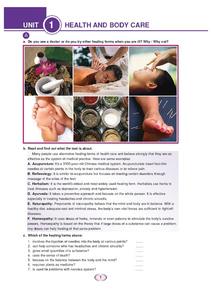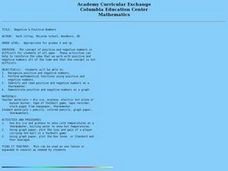Curated OER
Meadows Observations
Students investigate and examine the different living things they find in a meadow. Students record the different colors that are present and create a graph, identify and label parts of a plant, use a magnifying lens to examine all ...
Curated OER
The importance of names
In this Harry Potter instructional activity, students write descriptions for how J.K Rowling's titles of books used in the Harry Potter books are related to the author's name. Students complete 5 descriptions.
Curated OER
Prairie Dog Town
Fourth graders use their knowledge of prairie dog communities to design their own model prairie dog towns. Teachers are provided with background information on prairie dogs and are encouraged to show examples to stimulate creativity. ...
Curated OER
Solving Word Problems
In this word problems worksheet, 6th graders read the math word problems that incorporate a variety of math skills including finding perimeter, adding decimals, converting percentages to decimals, and solving fraction equations. Students...
Curated OER
By the Pound
Agriculture surrounds us every day; incorporate measuring tools into a study of Oklahoma's agricultural industry! Small groups read an informational text (included) before visiting stations where they investigate prices of various...
Alabama Learning Exchange
Make a Difference!
We are very dependent upon other life forms around us to survive. Here, scholars explore relationships in the ecosystem with the help of Auntie Litter and the pollution patrol. They imagine a world without grass, making connections to...
Curated OER
Paper Production
Young scholars compare paper making by hand and by assembly line. In this manufacturing lesson, students compare and contrast the two main ways to make paper, by hand or by machine. Young scholars research paper making and have a...
Utah Education Network (UEN)
Recipe Terminology Hunt
As your young learners develop into cooking enthusiasts, ensure their success in creating their next culinary masterpiece by preparing them to read and understand basic recipe terminology.
Curated OER
First Mention Rule Worksheet
Learners choose the correct article to fill in the blank before a countable or uncountable noun in a cloze-reading passage. They then determine the rule for the first mention of plural and singular non-count and countable nouns, as well...
Curated OER
Make Your Own Paper
Students create their own paper from recycled products. Students describe the steps of the paper-making process, then practice making their own.
Curated OER
Modernizing a Traditional Irish Folktale
Young scholars write their own folktales based on "Cathal O'Cruachan and the Cowherd." In discussions they examine the animal symbolism in the story, as well as the characters, events, problems, and solution. With partners, they select...
Prestwick House
In Cold Blood
In Cold Blood, Truman Capote's groundbreaking work in the world of nonfiction literature, is the focus of a quick review resource. Readers solve a crossword puzzle that offers clues about the book's characters and events.
Curated OER
Health and Body Care
In these health care and grammar worksheets, students complete several activities that teach them about spa treatments, fitness center activities, doctor visits, conjunction usage, paragraph format, and word usage.
Curated OER
Hippocratic Medical Rounds
A very interesting way to model Hippocrates allows your clas to to compare world views and to illustrate how ideas have changed at key times throughout the history of science. This simulation has young scholars role play patients and...
Curated OER
Negative and Positive Numbers
Help scholars explain the concept of positive and negative numbers. Here you will find three separate activities that will help them to correlate positive and negative numbers with real life. Note: Activities require that the teacher...
Curated OER
Healing Art: Health and Illness
Students examine African artifacts relating to health and illness
Curated OER
Agriculture in Your Life
Students examine the agricultural sources of everyday products and identify food products outside traditional farming circles. They discuss the background information, and complete activity sheets, locating various commodity locations on...
Curated OER
Forest Communities
Students identify tree specimens. For this tree specimens lesson, students collect different parts of a tree from the areas around the school or their home. They then work in groups to create booklet that identifies tree...
Curated OER
Echinacea No Cure all for Kids
Students look at real data and answer the question of whether or not they would recommend Echinacea to cure a cold. In this investigative lesson plan students describe whether the data supports the hypothesis that echinacea shortens the...
Curated OER
Foods Around the World
Bring the flavors of the world into your classroom with this tasty presentation on foods from around the globe. Spanish, Portuguese, Polish, Lithuanian, Welsh, and Italian foods are depicted with descriptions and colorful photos. Tip:...
Curated OER
Medicine, Technology and Society
Students compare and contrast traditional Chinese and contemporary Western approaches to medicine. They bring a rational and scientific approach to the evaluation of alternative medicines. They study acupuncture from a Chinese and...
Curated OER
Flower Pot Salad Bar
Learners discuss the connection between a flower pot and wholesome food by creating a salad. In this healthy eating lesson, students utilize numerous fresh vegetables to create a classic salad in a flower pot. Learners write...
Curated OER
A Ride for Liberty
In this American Civil War learning exercise, students examine a Eastman Johnson painting titled "A Ride for Liberty," and then respond to 2 short answer questions based on their analysis of the painting.
Curated OER
Parts of the Plants
Second graders discuss as a class what they know about plants viewing several pictures of plants as well as a tree poster. They work in groups to observe a flowering plant which is removed from a pot with the soil brushed away and is...























